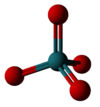Chemistry:Iridium tetroxide
From HandWiki

| |
| Names | |
|---|---|
| IUPAC name
Iridium(VIII) oxide
| |
| Identifiers | |
3D model (JSmol)
|
|
| |
| |
| Properties | |
| IrO4 | |
| Molar mass | 256.213 g·mol−1 |
| Melting point | −267.15 °C (−448.87 °F; 6.00 K) |
Except where otherwise noted, data are given for materials in their standard state (at 25 °C [77 °F], 100 kPa). | |
| Infobox references | |
Tracking categories (test):
Iridium tetroxide (IrO4, Iridium(VIII) oxide) is a binary compound of oxygen and iridium in oxidation state +8.[1] This compound was formed by photochemical rearrangement of [(η1-O2)IrO2] in solid argon at a temperature of 6 K (−267.15 °C; −448.87 °F). At higher temperatures, the oxide is unstable.[2] The detection of the iridium tetroxide cation IrO+4 by infrared photodissociation spectroscopy with formal oxidation state +9 has been reported, the highest currently known of any element.[3][4] However no salts are known, as attempted production of an Ir(IX) salt such as IrO4SbF6 did not result in anything.
References
- ↑ Gong, Yu; Zhou, Mingfei; Kaupp, Martin; Riedel, Sebastian (2009). "Formation and Characterization of the Iridium Tetroxide Molecule with Iridium in the Oxidation State +VIII". Angewandte Chemie International Edition 48 (42): 7879–7883. doi:10.1002/anie.200902733. PMID 19593837.
- ↑ Citra, Angelo; Andrew, Lester (1999). "Reactions of Laser-Ablated Iridium Atoms with O2. Infrared Spectra and DFT Calculations for Iridium Dioxide and Peroxoiridium(VI) Dioxide in Solid Argon". J. Phys. Chem. A 103 (21): 4182–4190. doi:10.1021/jp990388o. Bibcode: 1999JPCA..103.4182C.
- ↑ Himmel, D.; Knapp, C.; Patzschke, M.; Riedel, S. (2010). "How far can we go? Quantum-chemical investigations of oxidation state IX". ChemPhysChem 11 (4): 865–869. doi:10.1002/cphc.200900910. PMID 20127784.
- ↑ Wang, Guanjun; Zhou, Mingfei; Goettel, James T.; Schrobilgen, Gary J.; Su, Jing; Li, Jun; Schlöder, Tobias; Riedel, Sebastian (23 October 2014). "Identification of an iridium-containing compound with a formal oxidation state of IX". Nature 514 (7523): 475–477. doi:10.1038/nature13795. PMID 25341786. Bibcode: 2014Natur.514..475W.
External links
 |
